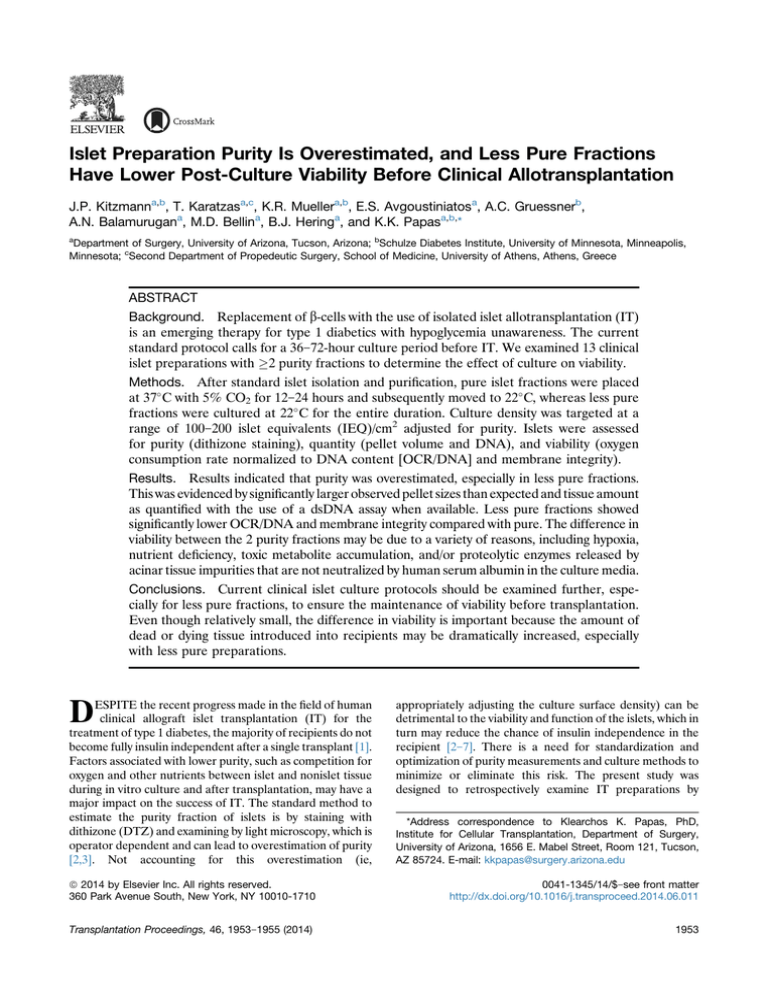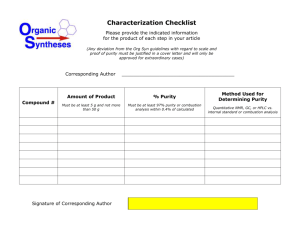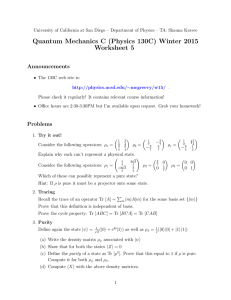
Islet Preparation Purity Is Overestimated, and Less Pure Fractions
Have Lower Post-Culture Viability Before Clinical Allotransplantation
J.P. Kitzmanna,b, T. Karatzasa,c, K.R. Muellera,b, E.S. Avgoustiniatosa, A.C. Gruessnerb,
A.N. Balamurugana, M.D. Bellina, B.J. Heringa, and K.K. Papasa,b,*
a
Department of Surgery, University of Arizona, Tucson, Arizona; bSchulze Diabetes Institute, University of Minnesota, Minneapolis,
Minnesota; cSecond Department of Propedeutic Surgery, School of Medicine, University of Athens, Athens, Greece
ABSTRACT
Background. Replacement of b-cells with the use of isolated islet allotransplantation (IT)
is an emerging therapy for type 1 diabetics with hypoglycemia unawareness. The current
standard protocol calls for a 36e72-hour culture period before IT. We examined 13 clinical
islet preparations with 2 purity fractions to determine the effect of culture on viability.
Methods. After standard islet isolation and purification, pure islet fractions were placed
at 37 C with 5% CO2 for 12e24 hours and subsequently moved to 22 C, whereas less pure
fractions were cultured at 22 C for the entire duration. Culture density was targeted at a
range of 100e200 islet equivalents (IEQ)/cm2 adjusted for purity. Islets were assessed
for purity (dithizone staining), quantity (pellet volume and DNA), and viability (oxygen
consumption rate normalized to DNA content [OCR/DNA] and membrane integrity).
Results. Results indicated that purity was overestimated, especially in less pure fractions.
This was evidenced by significantly larger observed pellet sizes than expected and tissue amount
as quantified with the use of a dsDNA assay when available. Less pure fractions showed
significantly lower OCR/DNA and membrane integrity compared with pure. The difference in
viability between the 2 purity fractions may be due to a variety of reasons, including hypoxia,
nutrient deficiency, toxic metabolite accumulation, and/or proteolytic enzymes released by
acinar tissue impurities that are not neutralized by human serum albumin in the culture media.
Conclusions. Current clinical islet culture protocols should be examined further, especially for less pure fractions, to ensure the maintenance of viability before transplantation.
Even though relatively small, the difference in viability is important because the amount of
dead or dying tissue introduced into recipients may be dramatically increased, especially
with less pure preparations.
D
ESPITE the recent progress made in the field of human
clinical allograft islet transplantation (IT) for the
treatment of type 1 diabetes, the majority of recipients do not
become fully insulin independent after a single transplant [1].
Factors associated with lower purity, such as competition for
oxygen and other nutrients between islet and nonislet tissue
during in vitro culture and after transplantation, may have a
major impact on the success of IT. The standard method to
estimate the purity fraction of islets is by staining with
dithizone (DTZ) and examining by light microscopy, which is
operator dependent and can lead to overestimation of purity
[2,3]. Not accounting for this overestimation (ie,
appropriately adjusting the culture surface density) can be
detrimental to the viability and function of the islets, which in
turn may reduce the chance of insulin independence in the
recipient [2e7]. There is a need for standardization and
optimization of purity measurements and culture methods to
minimize or eliminate this risk. The present study was
designed to retrospectively examine IT preparations by
*Address correspondence to Klearchos K. Papas, PhD,
Institute for Cellular Transplantation, Department of Surgery,
University of Arizona, 1656 E. Mabel Street, Room 121, Tucson,
AZ 85724. E-mail: kkpapas@surgery.arizona.edu
ª 2014 by Elsevier Inc. All rights reserved.
360 Park Avenue South, New York, NY 10010-1710
0041-1345/14/$esee front matter
http://dx.doi.org/10.1016/j.transproceed.2014.06.011
Transplantation Proceedings, 46, 1953e1955 (2014)
1953
1954
various methods of cell quantification and to evaluate the
effect of purity on islet viability after culture with the use of
oxygen consumption rate normalized to DNA content
(OCR/DNA) and membrane integrity stains.
METHODS
We retrospectively examined all human clinical islet allograft
preparations from the University of Minnesota with at least 2 purity
fractions (n ¼ 13) after 36e72 hours of the standard culture method
of IT [8]. After routine human islet isolation and purification, pure
islet fractions (70% purity estimated by DTZ staining) were
placed in an incubator at 37 C with 5% CO2 for 12e24 hours and
subsequently moved to 22 C. Less pure (30%e69% purity) fractions
were cultured at 22 C with 5% CO2 for the entire duration. Culture
density per T-175 flask was targeted at a range of 100e200 islet
equivalents (IEQ)/cm2 adjusted for purity (ie, 50e100 IEQ/cm2 for a
50% pure preparation). CMRL-1066 media volume was 30 mL per
T-175 flask, with 20 mL being replaced after 12e24 hours of culture
[9]. After the culture period, islets were assessed for purity, quantity, and viability.
Purity was estimated by removing 2 samples of 100e200 mL each
from the well mixed and presumed homogeneous tissue suspension
and adding DTZ. Samples were examined under a light microscope,
and the percent of red-stained cells was estimated as the purity [2,3,7].
Islet quantity was measured by 3 methods and estimated by 1
method: (1) A standard IEQ count was based on the DTZ samples,
in which islets 50 mm in diameter were stratified into groups of
50-mm increments and normalized to a 150-mm diameter size; (2) A
dsDNA fluorescent dye kit (Quant-it Picogreen dsDNA kit;
Molecular Probes, Eugene, Oregon) was used to measure the
quantity of DNA in each purity fraction; the total quantity of DNA
measured was converted to IEQ by assuming 1 IEQ ¼ 10.4 ng DNA
[2] and corrected for purity as measured by DTZ to be compared
with the IEQ counts; (3) For measuring the observed pellet volume,
ithe tissue was aspirated into a 10-mL glass pipette and allowed to
settle for 3e5 minutes, and the cell volume (mL) was then visually
observed; (4) The IEQ measured by method (1) was then used to
estimate the expected pellet volume to be compared with the
observed pellet volume; the expected pellet volume (mL) based on
the IEQ counts was determined by using the volume of an IEQ
which, being by definition a sphere with a diameter of 150 mm, is
1.77 106 mm3; for example, accounting for a w10% void fraction,
or the extracellular space between islets, a pellet size of 2 mL would
be expected to contain w1 106 IEQ of 100% pure islets, and 4 mL
would be expected to contain w1 106 IEQ of 50% pure islets.
Islet viability was assessed by 2 methods. The first method was by
membrane integrity staining with the use of an IT release assay
(viability must be 70%). Briefly, an aliquot of islets (80e100 IEQ)
were spun down and resuspended in 460 mL Dulbecco phosphatebuffered saline solution (DPBS), 10 mL 0.46 mmol/L fluorescine
diacetate (Sigma no F7378; inclusion dye in which viable cells
appear as bright green fluorescent), and 10 mL 14.34 mmol/L
propidium iodide (Sigma no P4170; exclusion dye which enters
ruptured cell membranes with a red/orange fluorescence). The cells
were then washed with DPBS and viewed under a fluorescent
microscope. Percentage viability was estimated as the area of green
cells (live) to total tissue [2,3]. The second method of assessing islet
viability was by measuring the OCR/DNA as detailed elsewhere
[2,7,10] with the use of a real-time in vitro assay that has been
validated as a quality assay in various animal models and the human
autograft model [11e13].
KITZMANN, KARATZAS, MUELLER ET AL
Statistical Techniques
All statistical analyses were performed with the use of the SAS
statistical software package, version 9.3 (SAS Institute, Cary, North
Carolina) or Graphpad Prism, version 5.03 (Graphpad Software, La
Jolla, California). Values are reported as mean SD. Statistical
significance was tested by a paired Student t test and corresponded
to P < .05.
RESULTS
The islet purity was typically grossly overestimated in all
fractions based on the comparison between observed and
expected pellet volumes, especially in the less pure fractions.
This was demonstrated by the significantly larger observed
pellet volumes relative to the volumes expected from the
counts (P ¼ .01 for pure; P ¼ .0001 for less pure; Fig 1A and
B). The overestimation of purity was also evidenced by the
significant difference between the actual IEQ counts and
the IEQ estimated from the dsDNA assay when available
(P ¼ .003 for pure; P ¼ .0001 for less pure; Fig 1C and D).
Less pure fractions showed a significantly lower viability
than pure fractions after culture as measured by both
OCR/DNA and membrane integrity stains (Fig 1E and F).
Mean SD OCR/DNA was 125 28 nmol O2/minmg
DNA for pure fractions and 99 19 for less pure fractions
(P ¼ .009). Based on membrane integrity, percentage
viability was 92 5% for pure fractions and 86 4% for
less pure fractions (P ¼ .003).
DISCUSSION
Among the major factors favoring successful IT, the islet
yield, the purity of preparations, and the viability of the
islets post-culture are critical for transplant outcome. Purity
has been traditionally measured by visual estimation
of preparations stained with DTZ, and this test gave
20%e30% erroneously higher values on average compared
with more rigorous assessments of islet preparation fractions, such as electron microscopy or laser scanning
cytometry [4,5,7]. Street et al reported that when comparing
islet purity assessed by DTZ staining with results with the
use of immunostaining to quantify total endocrine cellular
composition, the DTZ-based purity assessment gave significantly higher results than those indicated by the endocrine
immunostaining [6]. Furthermore, it is known that individual estimates from DTZ staining are subject to considerable
observer variability [6,14,15].
The results from this study indicate that the purity by
DTZ staining is typically grossly overestimated in all fractions and especially in less pure ones. This was evidenced by
observing significantly larger settled tissue volumes and
estimated IEQ from DNA quantities than what was
expected based on the counts. This overestimation could be
the cause of lower viability in the less pure preparations
after culture. The cells may have been exposed to hypoxia
and/or nutrient deficiency, because the culture density
would be much higher than desired [16]. Another possible
OVERESTIMATION OF ISLET PREPARATION PURITY
1955
A
B
E
C
D
F
cause of the difference in viability may be toxic metabolite
accumulation and/or proteolytic enzymes released by the
acinar tissue impurities that are not neutralized by human
serum albumin during culture [17]. In addition, there may
be a preferential loss of viability in nonislet tissue, which
would explain the lower viability in less pure fractions.
In conclusion, current clinical islet purity measurements
and culture protocols should be examined and further
refined to ensure the maintenance of viability after culture
and before transplantation. Even though relatively small,
the difference in viability observed with purity is important
as the amount of total and thus dead tissue introduced in
recipients may be dramatically increased, especially with less
pure preparations.
ACKNOWLEDGMENTS
This work was supported in part by a grant from the NIH/NIDDK
Phase II SBIR DK069865.
REFERENCES
[1] Collaborative Islet Transplant Registry. CITR Sixth Annual
Report 2009. Available at: https://web.emmes.com/study/isl/
reports/CITR%206th%20Annual%20Data%20Report%20120109.
pdf. Accessed May 3, 2013.
[2] Colton CK, Papas KK, Pisania A, et al. Characterization of
islet preparations. In: Halberstadt C, Emerich DF, editors. Cell
transplantation from laboratory to clinic. New York: Elsevier; 2007.
pp. 35e132.
[3] Boyd V, Cholewa OM, Papas KK. Limitations in the use of
fluorescein diacetate/propidium iodide (FDA/PI) and cell permeable nucleic acid stains for viability measurements of isolated islets
of langerhans. Curr Trends Biotechnol Pharm 2008;2:66e84.
[4] Pisania A, Weir GC, O’Neil JJ, et al. Quantitative analysis of
cell composition and purity of human pancreatic islet preparations.
Lab Invest 2010;90:1661e75.
Fig 1. Observed values plotted against
theoretical expected values for (A,B) pellet
volume, (C,D) islet density (islet equivalents [IE]/cm2) in culture flasks as
measured by counts and DNA, and (E,F)
islet preparation viability for separate
purity fractions as measured by oxygen
consumption rate normalized to DNA content (OCR/DNA) and membrane integrity
staining for 13 clinical islet preparations.
[5] Ichii H, Inverardi L, Pileggi A, et al. A novel method for the
assessment of cellular composition and beta-cell viability in human
islet preparations. Am J Transplant 2005;5:1635e45.
[6] Street CN, Lakey JRT, Shapiro AMJ, et al. Islet graft
assessment in the Edmonton protocol. Implications for predicting
long-term clinical outcome. Diabetes 2004;53:3107e14.
[7] Papas KK, Suszynski TM, Colton CK. Islet assessment for
transplantation. Curr Opin Organ Transplant 2009;14:674e82.
[8] Shapiro AMJ, Ricordi C, Hering BJ, Auchincloss H,
Lindblad R, et al. International trial of the Edmonton protocol for
islet transplantation. N Engl J Med 2006;355:1318e30.
[9] Clinical Islet Transplantation Study. Purified human pancreatic islets master production batch record. Available at: http://www.
isletstudy.org/CITDocs/SOP%203101,%20B01,%20MPBR%20v05,
%20October%2028,%202010.pdf. Accessed May 3, 2013.
[10] Papas KK, Pisania A, Wu H, Weir GC, Colton CK. A stirred
microchamber for oxygen consumption rate measurements with
pancreatic islets. Biotechnol Bioeng 2007;98:1071e82.
[11] Papas KK, Colton CK, Nelson RA, Rozak PR,
Avgoustiniatos ES, Scott WE 3rd, et al. Human islet oxygen consumption rate and DNA measurements predict diabetes reversal in
nude mice. Am J Transplant 2007;7:707e13.
[12] Papas KK, Colton CK, Qipo A, et al. Prediction of marginal
mass required for successful islet transplantation. J Invest Surg
2010;23:28e34.
[13] Papas KK, Bellin MD, Sutherland DE, et al. Clinical islet
auto-transplant outcome is highly correlated with viable isle dose as
measured by oxygen consumption rate. CellR4 2013;1:108.
[14] Ricordi C, Gray DW, Hering BJ, et al. Islet isolation
assessment in man and large animals. Acta Diabetol 1990;27:
185e95.
[15] Ricordi C. Quantitative and qualitative standards for islet
isolation assessment in humans and large mammals. Pancreas
1991;6:242e4.
[16] Papas KK, Avgoustiniatos ES, Tempelman LA, et al.
High-density culture of human islets on top of silicone rubber
membranes. Transplant Proc 2005;37:3412e4.
[17] Avgoustiniatos ES, Scott WE III, Suszynski TM, et al.
Supplements in human islet culture: human serum albumin
is inferior to fetal bovine serum. Cell Transplant 2012;21:
2805e14.


